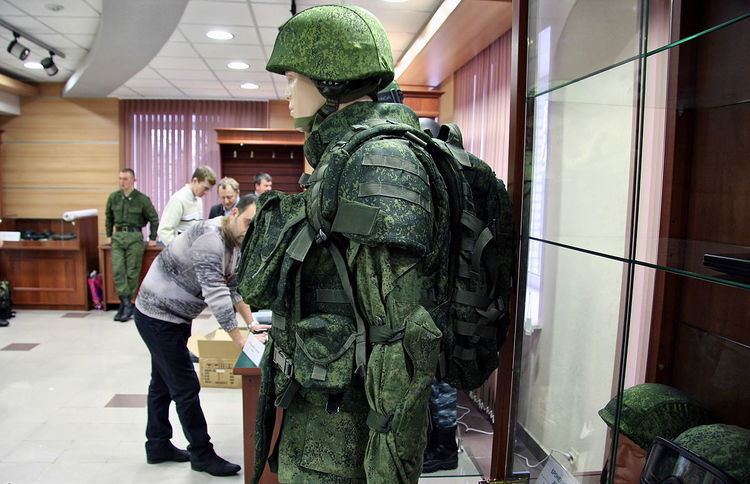 | ||
Ratnik (Russian: Ратник; Warrior) is a Russian infantry combat system. It is designed to improve the connectivity and combat effectiveness of the Russian Army. Improvements include modernized body armour, helmet with special monitor (eye monitor, thermal, night vision monocular, flashlight), systems of communication and special headphones. It includes 10 subsystems and 59 items. As of October 2016, it has already been used in combat.
The "Strelets" ("Musketeer") system gives ability of voice and video communication. Also, it includes a GLONASS navigation module, so a squad leader can see location of each soldier on his small, book-sized, computer. With this computer, he also can give orders to his squad, send videos and photos to headquarters. Each soldier has his own tactical computer, but instead of the leader's computer, this one is smaller, telephone-sized.
"Ratnik" protects almost 90% of soldier's body. The main body armour (Standard vest) is in GOST R 50744-95 Level V rated, weighs 7.5 kg (with the Assault variant weighing up to 15 kg). The main body armour fully protects from 7.62×39mm rounds from assault rifles, and 7.62×54mmR from sniper rifles, not excluding the increased penetration of hardened rounds, and can survive hits from repeated shots in these calibres conducted at close range. In general, weight of full "Ratnik" equipment with the special thigh and shoulder bulletproof shields is 19–20 kg. Basic "Ratnik" gear (for engineers and medics) weighs 15 kg (without thigh and shoulder guards).
"Ratnik" passed all of the tests, and has been adopted by the Russian Armed Forces on 23 October 2014. For the Russian Navy and Engineering Troops, the bulletproof vest is combined with the life vest, so soldiers and sailors that are thrown into the water won't drown. All Naval Infantry units were equipped with Ratnik gear as of November 2016.
Serial deliveries and batch production of Ratnik began in the first half of 2015. The Defence Ministry is said to buy 50,000 sets annually.
Prototypes Ratnik kits have already been distributed to selected units in the Ground Forces according to Oleg Martyanov, a member of Russia's Military-Industrial Commission, which acts as the government's liaison with the defense industry. According to other sources, the Ratnik system underwent final acceptance tests in late 2013. All the equipment of Ratnik (firearms, body armour, optic, communication and navigation devices, medical, and power supply systems, as well as uniform items such as knee and elbow pads) have been tested and accepted into service. Initially only elite troops will receive the AK-12 as part of the Ratnik system, while the rest of the Ground Forces will continue using the AK-74 into the 2020s. 80,000 sets were delivered in 2015. About 120,000 sets have been delivered as of autumn 2016.
